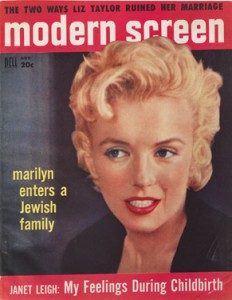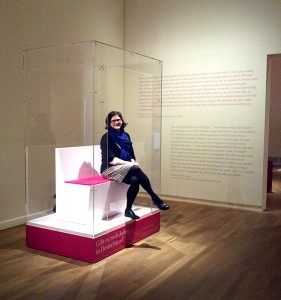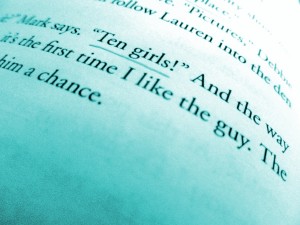Search Results for
"question"
Why a particular subject captures the interest of the public at a given time is not always immediately apparent. Conversion, for instance, has become the topic of conferences, lectures and exhibits in German-speaking Europe without any notable change in its social significance nor religious practice.

Picture in the current special exhibition “The Whole Truth” accompanying the question: Jew or non-Jew? Marilyn Monroe on the cover of the Modern Screen Magazine, November 1956
© Jewish Museum Berlin, photo: Jens Ziehe
The number of converts to Judaism is invariably small. According to the data collected by the Zentralwohlfahrtsstelle der Juden in Deutschland, on average 64 conversions are carried out yearly in the various German-Jewish communities, and since the year 2000, the number has remained fairly stable. Nor has the size of the Jewish communities varied much. For over a decade, the number of members has stabilized at around 105.000. In relation to the size of the community, the total number of converts since 1990, 1.366, makes up under one percent of the Jewish community. The number of Jews leaving the communities is slightly higher, around one hundred a year, yet the number is not particularly meaningful, because it includes people who leave for all sorts of reasons, including financial. By all accounts, today’s Jewish converts are a minute and exotic minority.
Yet the topic is currently being discussed with much enthusiasm. (more…)
My Two Hours as a Living Exhibition Object in the Show “The Whole Truth“
This was a truly extraordinary experience. The best moments were when the visitors started talking not just to me but to each other, and we wound up talking about Wagner and the weather rather than ‘just’ about growing up Jewish – or, more specifically, in my case as the daughter of a Jewish-American mother and a German, (formerly) Protestant father – in Germany and how odd it was to be sitting in a glass showcase in an exhibition.

Signe Rossbach in the exhibition “The Whole Truth”, April 8, 2013
© Jewish Museum Berlin, photo: Michal Friedlander
I was reminded of the moment in 1998 when I returned to Germany from the U.S. (although I did not want to see it that way at the time). The German publisher I was working for in New York had just been appointed State Minister of Culture by Gerhard Schröder, and I continued working for him in the Federal Chancellery, first in Bonn, then in Berlin. Back in New York, an editor at Henry Holt said to me: “Well, well, isn’t that a great job for a good little Jewish girl, working in the German government?” I thought about it, and said: “Exactly.”
So, I guess this was what brought me to sit in a glass showcase in a show at the Jewish Museum Berlin, where I have been working for twelve years now, on a seemingly quiet Monday afternoon. In my two hours of being a living exhibition object, I … (more…)
 In the past, a number of literary texts on Jewish topics contributed to Jewish culture in various ways. Some documented and revitalized oral history and folk tales in an attempt to save them from oblivion (e.g. Martin Buber’s Tale of the Hasidim); others made Jewish topics palatable to the majority society (e.g. Sidney Taylor’s All-of-a-Kind Family); and still others helped to build a Jewish community around shared experiences of ritual, emigration and persecution (e.g. Friedrich Torberg’s Tante Jolesch or The Decline of the West in Anecdotes).
In the past, a number of literary texts on Jewish topics contributed to Jewish culture in various ways. Some documented and revitalized oral history and folk tales in an attempt to save them from oblivion (e.g. Martin Buber’s Tale of the Hasidim); others made Jewish topics palatable to the majority society (e.g. Sidney Taylor’s All-of-a-Kind Family); and still others helped to build a Jewish community around shared experiences of ritual, emigration and persecution (e.g. Friedrich Torberg’s Tante Jolesch or The Decline of the West in Anecdotes).
Nathan Englander, one of the most sophisticated and provocative current writers, shares none of these intentions. His latest book, What We Talk About When We Talk About Anne Frank, is a collection of eight short stories loosely bound together under the title of (and a quote from) the first story, arising from a heated conversation about genocide; it refers to Anne Frank not as a historical figure, but as a metonym of victimhood. Accordingly, the stories reflect on the effect of Jewish themes, such as religion, the Holocaust and Israel, on modern Jewish identities. The author’s perspective is from within – he was born in 1970 to an Orthodox-Jewish family in New York – and critical. His gripping, intimate theatre-like episodes are fraught with tense dialog questioning the validity of Jewish cultural practice: (more…)


